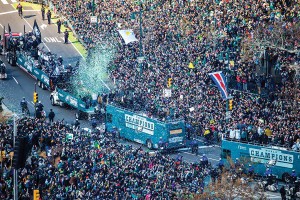No More Jim Gardner? No More Chris May?
Imagine local TV news without Jim Gardner or Renee Chenault-Fattah or Chris May.
Oh, the horror.
For Delaware Valley viewers, such a scenario is a nightmare of unfathomable proportions. But if these anchors were working for Tribune Co. instead of 6ABC, NBC10 and CBS3, it could happen.
Here’s why: Looking to “blow up” formulaic local newscasts, Tribune wants to eliminate anchors and reporters from view and replace them with a new format called NewsFix. (Sounds like a controlled substance for information junkies.)
NewsFix features a rolling collection of stories, using natural sound and video. Reporters are heard, but not seen. Tribune’s first lab rat will be Houston’s last-place KIAH (a CW affiliate) in the fall. The 22 other Tribune-owned stations — including Philadelphia’s myphl 17and its 10 p.m. news — are expected to follow.
“We are about to launch a TV newscast in Houston that has no anchors, that has great pictures and great writing, but doesn’t involve a set or a desk or anyone standing in the way of the picture,” Tribune CEO Randy Michaels told the Wall Street Journal yesterday.[SIGNUP]
The brainchild of Lee Abrams, Trib’s chief innovation officer and, like his boss, a former radio guy, NewsFix is designed to break “the grip of the 1970s television playbook that seems to be what every station in America is addicted to,” he told the Chicago Tribune.
Bottom line, it’s all about the Benjamins. By re-assigning anchors and reporters to other off-camera tasks, bankrupt Tribune could demand further salary cuts and liquidate some tech jobs. Also, there’s money to be saved by phasing out expensive sets.
What? No sets appeal? CBS3 anchor May, for one, is outraged.
“This is the worst idea I ever heard in my life,” says May, who anchors at 4, 6 and 11 p.m. “It would be a great blow to the makeup industry as well as broadcast journalism.”
In a more serious vein, May has real concerns. Losing the “human element” in a newscast “is an ugly proposition,” he says, because showcasing your on-air talent is the most effective way to connect with the community. Viewers relate to people, not news. CNN learned that the hard way.
Moreover, when there is breaking news, a newscast needs an experienced anchor who “knows how to boil down the story to its core and explain it,” May says. “You can’t replace that with some random narration.”
Oh yeah? Stay tuned.


